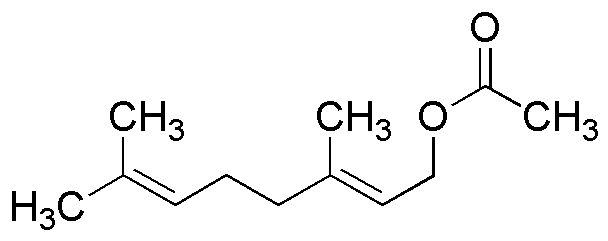Geranyl acetate is widely utilized in research focused on:
- Fragrance Industry: This compound is a key ingredient in perfumes and cosmetics, providing a pleasant floral scent. Its natural aroma makes it a popular choice for formulating high-quality fragrances.
- Flavoring Agent: In the food industry, geranyl acetate is used to impart a fruity flavor to various products, such as candies and beverages, enhancing their sensory appeal.
- Aromatherapy: This chemical is often included in essential oil blends for its calming and uplifting properties, making it a favorite among practitioners of holistic health and wellness.
- Pharmaceuticals: Geranyl acetate has potential applications in drug formulation, where it can act as a solvent or carrier for active ingredients, improving their stability and absorption.
- Biopesticides: In agriculture, this compound is explored for its insect-repelling properties, offering a more natural alternative to synthetic pesticides, which can be harmful to the environment.
General Information
Properties
Safety and Regulations
Applications
Geranyl acetate is widely utilized in research focused on:
- Fragrance Industry: This compound is a key ingredient in perfumes and cosmetics, providing a pleasant floral scent. Its natural aroma makes it a popular choice for formulating high-quality fragrances.
- Flavoring Agent: In the food industry, geranyl acetate is used to impart a fruity flavor to various products, such as candies and beverages, enhancing their sensory appeal.
- Aromatherapy: This chemical is often included in essential oil blends for its calming and uplifting properties, making it a favorite among practitioners of holistic health and wellness.
- Pharmaceuticals: Geranyl acetate has potential applications in drug formulation, where it can act as a solvent or carrier for active ingredients, improving their stability and absorption.
- Biopesticides: In agriculture, this compound is explored for its insect-repelling properties, offering a more natural alternative to synthetic pesticides, which can be harmful to the environment.
Documents
Safety Data Sheets (SDS)
The SDS provides comprehensive safety information on handling, storage, and disposal of the product.
Product Specification (PS)
The PS provides a comprehensive breakdown of the product’s properties, including chemical composition, physical state, purity, and storage requirements. It also details acceptable quality ranges and the product's intended applications.
Certificates of Analysis (COA)
Search for Certificates of Analysis (COA) by entering the products Lot Number. Lot and Batch Numbers can be found on a product’s label following the words ‘Lot’ or ‘Batch’.
*Catalog Number
*Lot Number
Certificates Of Origin (COO)
This COO confirms the country where the product was manufactured, and also details the materials and components used in it and whether it is derived from natural, synthetic, or other specific sources. This certificate may be required for customs, trade, and regulatory compliance.
*Catalog Number
*Lot Number
Safety Data Sheets (SDS)
The SDS provides comprehensive safety information on handling, storage, and disposal of the product.
DownloadProduct Specification (PS)
The PS provides a comprehensive breakdown of the product’s properties, including chemical composition, physical state, purity, and storage requirements. It also details acceptable quality ranges and the product's intended applications.
DownloadCertificates of Analysis (COA)
Search for Certificates of Analysis (COA) by entering the products Lot Number. Lot and Batch Numbers can be found on a product’s label following the words ‘Lot’ or ‘Batch’.
*Catalog Number
*Lot Number
Certificates Of Origin (COO)
This COO confirms the country where the product was manufactured, and also details the materials and components used in it and whether it is derived from natural, synthetic, or other specific sources. This certificate may be required for customs, trade, and regulatory compliance.

